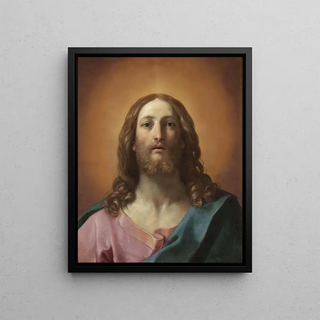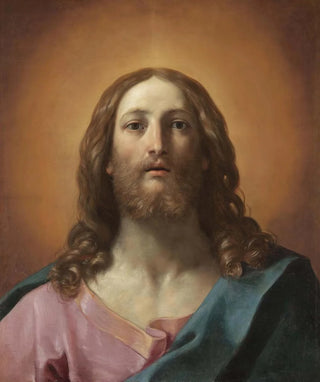Art print | Bust of Christ - Guido Reni


View from behind

Frame (optional)
The Christ Bust Art print by Guido Reni, an iconic work from the 17th century, embodies the essence of beauty and spirituality in Baroque art. This striking representation of Christ, with a face filled with serenity and compassion, invites viewers to a profound contemplation. Through this bust, Reni manages to capture not only the physical appearance of Christ but also his divine dimension, creating a bridge between the earthly and the celestial. The piece, through its evocative power, continues to resonate in hearts and minds, demonstrating the technical mastery and artistic sensitivity of its creator.
Style and uniqueness of the work
Guido Reni's style is distinguished by its clarity, brightness, and meticulous attention to detail. In the Christ bust, light plays a fundamental role, highlighting the delicate features of the face and creating a play of shadows that adds depth and relief to the piece. The softness of the contours, combined with a palette of warm colors, evokes an atmosphere of peace and redemption. Reni employs sfumato techniques, rendering the transitions between shadows and lights almost imperceptible, which enhances the spiritual dimension of his subject. The posture of Christ, slightly tilted, and his penetrating gaze seem to address the viewer directly, establishing a silent and intimate dialogue that transcends time and space.
The artist and his influence
Guido Reni, a major figure of Italian Baroque, left a lasting mark on his era with his unique style and ability to fuse classical technique with deep emotions. Trained in the shadow of great masters like Carracci, Reni developed an artistic approach that combines academic rigor with poetic sensitivity. His works, often inspired by religious themes, reflect a constant pursuit of ideal beauty. Reni's influence extends far beyond his time, affecting generations of artists who saw in him a role model to follow. His ability to express spirituality through the human form paved the way for various interpretations of the sacred in art, making him an essential pillar of art history.

Matte finish

View from behind

Frame (optional)
The Christ Bust Art print by Guido Reni, an iconic work from the 17th century, embodies the essence of beauty and spirituality in Baroque art. This striking representation of Christ, with a face filled with serenity and compassion, invites viewers to a profound contemplation. Through this bust, Reni manages to capture not only the physical appearance of Christ but also his divine dimension, creating a bridge between the earthly and the celestial. The piece, through its evocative power, continues to resonate in hearts and minds, demonstrating the technical mastery and artistic sensitivity of its creator.
Style and uniqueness of the work
Guido Reni's style is distinguished by its clarity, brightness, and meticulous attention to detail. In the Christ bust, light plays a fundamental role, highlighting the delicate features of the face and creating a play of shadows that adds depth and relief to the piece. The softness of the contours, combined with a palette of warm colors, evokes an atmosphere of peace and redemption. Reni employs sfumato techniques, rendering the transitions between shadows and lights almost imperceptible, which enhances the spiritual dimension of his subject. The posture of Christ, slightly tilted, and his penetrating gaze seem to address the viewer directly, establishing a silent and intimate dialogue that transcends time and space.
The artist and his influence
Guido Reni, a major figure of Italian Baroque, left a lasting mark on his era with his unique style and ability to fuse classical technique with deep emotions. Trained in the shadow of great masters like Carracci, Reni developed an artistic approach that combines academic rigor with poetic sensitivity. His works, often inspired by religious themes, reflect a constant pursuit of ideal beauty. Reni's influence extends far beyond his time, affecting generations of artists who saw in him a role model to follow. His ability to express spirituality through the human form paved the way for various interpretations of the sacred in art, making him an essential pillar of art history.






